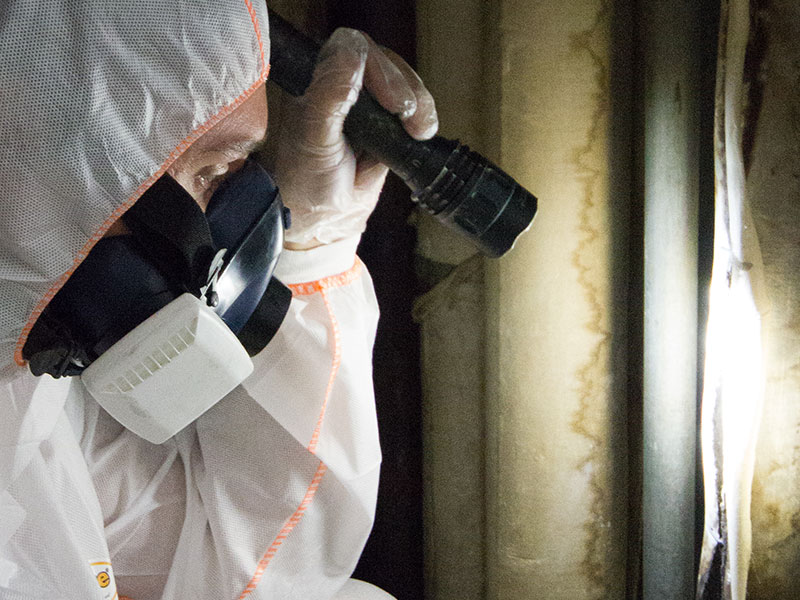Best practices for dealing with asbestos in the workplace
It might have been more than two decades now since it was last legal to use asbestos as a construction material in the UK, but the notoriously carcinogenic mineral remains one that needs to be responsibly managed on work premises where it is still present.
Although the substance was once extremely widely used as a building material during the 20th century – particularly from approximately the 1950s until the 1980s – it was ultimately banned in 1999. This was in recognition of the very serious health risks that the material posed to those who inhaled or ingested its fibres.
While the banning of asbestos prevented it from being used in future construction projects, there has never been an automatic requirement for the material to be removed from UK buildings where it was already present at the time of the 1999 ban. This means that in such buildings, there remains a particular need to manage the risks asbestos can present, in order to ensure employee safety.
However, confusion can often arise on the subject of dealing with asbestos in the workplace, including the matter of who is responsible for managing it, and what steps those responsible should take. Below, then, we have set out a comprehensive rundown of these aspects.
Understanding asbestos
A naturally occurring fibrous silicate mineral, asbestos was first commercially mined in the mid-19th century, and came to be heavily used in all manner of products that can now be found in commercial, public, and residential buildings alike. The material was so popular due to such factors as its relative affordability and availability, physical strength, and fire resistance.
As a consequence, in buildings constructed or refurbished during the 20th century, up until the 1999 ban, there are many different products that could conceivably contain asbestos, including the likes of asbestos insulating board (AIB), floor tiles, textured coatings, and roofing felt.
However, the ingestion or inhalation of asbestos fibres can also present an elevated risk of the person exposed going on to develop certain serious diseases, such as mesothelioma, asbestos-related lung cancer, or asbestosis.
Sadly, it took until around the 1970s for these health risks to become reasonably widely known among the public. This helped bring about the political pressure that culminated in all forms of asbestos finally being outlawed in the UK by the end of that century.
Responsibilities and accountability
When it comes to dealing with asbestos in the workplace, one of the biggest potential points of confusion is the question of who is actually responsible for this (certainly from a legal standpoint).
As a general rule, it is the person or organisation that is in charge of maintaining or repairing a given non-domestic property, that will also be responsible for managing any asbestos risks that may be present. In practice, this usually means whoever is the leaseholder or owner of the property.
In the event of a given building being occupied by multiple individuals or organisations, the leaseholder will typically be responsible for the parts of the building that it occupies. This will leave the owner with responsibility for the premises’ communal or common areas.
If you are the leaseholder for the building in question, it is worth looking at your lease contract to see whether this subject is specifically addressed. If the contract does not set out that you are responsible for maintaining the parts of the property you rent, it is likely to be the property owner who has the status of “dutyholder” under the Control of Asbestos Regulations 2012 (CAR 2012).
Steps for asbestos management
If you do indeed turn out to be the dutyholder for your workplace under CAR 2012, you will find more information on the steps you will need to take within the CAR 2012 legislation.
But as the legislation itself can make for a rather dense read, let’s outline some of those steps now. Dutyholders are expected under these regulations, for example, to take reasonable steps to determine whether there are asbestos-containing materials (ACMs) in the property for which they are responsible. And if ACMs do turn out to be present, the dutyholder will need to discover the locations, amounts, and condition of any such materials on site.
As the dutyholder in accordance with CAR 2012, you must presume that materials contain asbestos unless there is strong evidence of this not being the case. You will also need to make, and keep up to date, a record of the confirmed or suspected ACMs, in addition to putting together a plan that outlines in detail what will be done to manage asbestos risks on the property. You will then be expected to follow this up by actually putting the plan into action.
To put the situation in practical rather than purely regulatory terms, to determine the above information, you will need to arrange for the relevant asbestos surveying and assessment processes to be carried out. This will allow for the identification and documentation of any ACMs that turn out to be present.
From this point on, you will have the information that you will need in order to take further steps to control the risks asbestos might present to those using your workplace. Lest we forget, this might include visitors and customers, as well as employees of any organisations based in the property.
Such measures could include the proper labelling and signage of areas of the building containing asbestos, if there is any risk of the discovered materials being disturbed.
You should also be arranging for subsequent regular inspections and maintenance of the ACMs on your site over time. There isn’t a single catch-all answer to the question of exactly how frequently you should have new surveying carried out, as it depends on such factors as the work you might intend to do on-site, and whether the asbestos is being managed. We have previously written on this subject in depth here at Oracle Solutions.
Should asbestos be removed?
As we touched on above, there isn’t actually anything in UK law that requires asbestos to be removed in any and all instances in which it might be found in a building.
This helps to explain why there are believed to be around 1.5 million buildings in the UK that still contain asbestos. It is a situation that The Sunday Times has recently focused on, inspiring a campaign it has launched for the more widespread phased removal of asbestos from ageing UK properties, such as schools and hospitals.
In the meantime, the UK Health and Safety Executive (HSE)’s guidance continues to be that if asbestos is in good condition and is not disturbed or damaged, it presents negligible risk to health. Indeed, the workplace health and safety regulator has even stated that removing asbestos “unnecessarily” could be a more dangerous practice than leaving it in place and managing it.
So, as the dutyholder for your workplace or commercial building, you will need to assess whether any ACMs you have discovered can be safely contained and protected from being disturbed. You might ultimately decide on an alternative to removal, such as encasement or encapsulation.
Alternatively, you may determine that the risks necessitate the material being removed from your property altogether. By hiring suitably qualified asbestos removal professionals, you can arrange for this task to be done in the safest and most effective way, giving you the utmost peace of mind.
Asbestos awareness and training
Asbestos training is not necessarily only relevant to those who directly work within the asbestos industry. As we have previously explained in our comprehensive guide to asbestos training here at Oracle Solutions, the most basic asbestos training is actually asbestos awareness training.
Asbestos awareness training should be provided to anyone who carries out work within or on any building or structure where asbestos may be present. It is a form of training that is intended to give workers and supervisors the information they need to avoid work that could disturb asbestos. In other words, it does not prepare anyone to directly carry out work on ACMs.
If, on the other hand, a given employee or contractor of yours will be undertaking work that will definitely cause ACMs to be disturbed on your site, a higher level of training will be required. So, you will need to carefully consider the asbestos awareness or other training requirements that may apply to your own workers.
Conclusion: a thorough asbestos management programme will greatly help ensure safety
Throughout this article, we have addressed various best practices that you are advised to follow to ensure asbestos is suitably dealt with in your workplace. Those include carrying out the necessary steps, as set out by CAR 2012, to determine whether ACMs are present in your building at all, as well as undertaking further surveying of the property over time, and ensuring anyone liable to disturb asbestos on your site has adequate training.
Such practices will be essential if you are to achieve compliance with the relevant regulations and ensure the very greatest safety of your workers and other people who may use your premises.
To learn more about our own wide-ranging asbestos management, surveying, and training services here at Oracle Solutions, please feel free to email us or to call our team today.

Written by Brendan Coleman
Brendan Coleman, with decades of experience in the asbestos industry, is a dedicated Quality Manager. Certified as a surveyor and analyst, he is adept in operations and quality management with a keen focus on HSE compliance. His expertise is pivotal in maintaining high safety and efficiency standards. Brendan ensures our UKAS accreditation requirements are consistently met and exceeded, upholding stringent standards in asbestos remediation. His commitment to enhancing quality and customer satisfaction makes him an essential advisor in asbestos management.

